Saskatoon John G. Diefenbaker International Airport
| Saskatoon John G. Diefenbaker International Airport Saskatoon International Airport |
|||
|---|---|---|---|
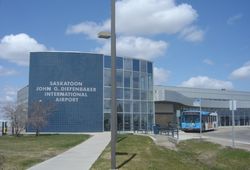 |
|||
IATA: YXE – ICAO: CYXE
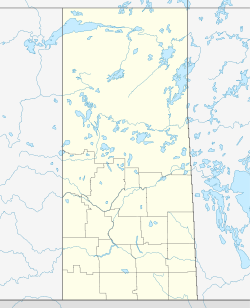 YXE
|
|||
| Summary | |||
| Airport type | Public | ||
| Owner | Transport Canada | ||
| Operator | Saskatoon Airport Authority | ||
| Serves | Saskatoon, Saskatchewan | ||
| Elevation AMSL | 1,654 ft / 504 m | ||
| Website | |||
| Runways | |||
| Direction | Length | Surface | |
| ft | m | ||
| 09/27 | 8,300 | 2,530 | Asphalt |
| 15/33 | 6,200 | 1,890 | Asphalt |
| Statistics (2008/2009) | |||
| Aircraft Movements | 93,083 (2009) | ||
| Passengers | 1,157,393 (2009) | ||
| Sources: Canada Flight Supplement,[1] Transport Canada[2] Movements from Statistics Canada[3] Passengers from Saskatoon Airport Authority 2009 Annual Report[4] |
|||
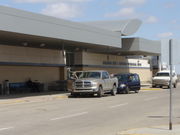
Saskatoon John G. Diefenbaker International Airport (IATA: YXE, ICAO: CYXE), is an international airport located 3 NM (5.6 km; 3.5 mi) northwest of Saskatoon, Saskatchewan Canada. The airport is serviced by passenger, courier and air freight operators.
The airport is classified as an airport of entry by NAV CANADA and is staffed by the Canada Border Services Agency. CBSA officers at this airport can handle aircraft with no more than 200 passengers, however they can handle up to 300 if the aircraft is unloaded in stages.[1]
In 2001, traffic in YXE exceeded 800,000 passengers, making YXE the largest airport in the province; by 2005 traffic reached over 900,000 passengers.[5] In 2007 passenger traffic exceeded the 1,000,000 mark.[6] With 93,083 aircraft movements in 2009 it was the 22nd busiest airport in Canada.[3]
The airport has six passenger bridges, five ground loading positions, 32 check-in points and a customs/immigration arrivals area. Some bridges can handle aircraft as large as the Boeing 747.[7] The airport has designs ready for two additional apron expansions that will be constructed when required to meet demand.
Contents |
History
On June 1, 1929 the city of Saskatoon was given a "License For Air Harbour" and the airport was established, this provided a home for the Saskatoon Aero Club.[8][9]
In 1940 the city leased the airport to the Royal Canadian Air Force. The airport became RCAF Station Saskatoon. During the war years this was part of the British Commonwealth Air Training Plan, with the Canadian Forces No. 4 Flight Training School established at the airport. To support these operations four large hangars were built as well as support buildings including a hospital and control tower.
After the war (1947) the airport was transferred to the Canadian Department of Transport for civilian use. That year Trans-Canada Air Lines, now known as Air Canada, started providing passenger service using DC-3 aircraft.
Air Canada in 1950 began operating the Canadair North Star at the airport, followed by the Vickers Viscount in 1955. A new terminal building was also constructed in 1955. The primary runway (09/27) was lengthened in 1954 and again in 1960 to 8,300 ft (2,530 m). While the secondary runway (15/33) was lengthened in 1963 to 6,200 ft (1,890 m).
As a result of the RCAF's post-war expansion, the RCAF re-acquired the military portion of the property and RCAF Station Saskatoon re-opened as an air training facility in October 1950. That same year, No. 23 Wing was formed to oversee 406 (Linx) Squadron and several other Auxiliary (Reserve) Squadrons in Western Canada. Permanent Married Quarters were built at the end of 1952, and the following year, the Air Marshall Curtis School opened for the children of station personnel.
No. 1 Advance Flying School opened at the station in 1952, one of the many Flying Training Schools opened across Canada to train RAF, RCAF and NATO aircrews. Students at the school trained on Mitchell Bombers and Expeditor aircraft trainers. Other lodger units at the station included, No. 3043 Technical Training Unit (Auxiliary) and No. 4002 Medical Unit (Auxiliary).
In 1956, the Instrument Flying School moved to Saskatoon from RCAF Station Centralia.
In 1962, control of RCAF Station Saskatoon was transferred from Training Command to Air Transport Command, but this change would be short-lived. RCAF Station Saskatoon closed in 1964 and both 406 Squadron and 23 Wing were disbanded.
RCAF Detachment No. 1005 Technical Support Depot was established at the site, serving as a disposal and storage facility for disused aircraft. This detachment remained at the Saskatoon Airport until closing in 1978.
Due to larger aircraft and more frequent flights, in 1972 plans were drafted for a new terminal building. The new terminal was completed and opened on November 29, 1975. The former terminal was renovated in 1977. From 1977 to 1984 Boeing 747 charter flights were operated by Wardair to Europe until Wardair was bought by Canadian Airlines International.
In 1993 the name of the airport was changed to recognize Canada's 13th Prime Minister John Diefenbaker. In 1995 under the Canada-US Open Skies agreement Northwest Airlines started service to Minneapolis – Saint Paul. In 1996 WestJet began Boeing 737-200 service. In 1999 the airport was turned over to the Saskatoon Airport Authority, as part of the National Airports Policy.
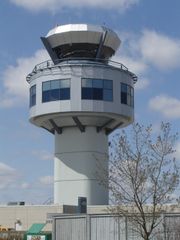
In 2000 NAV CANADA constructed a new control tower and the airport authority began renovations and expansions to the terminal building. In October 2002 the first two phases of renovations to the air terminal building was completed at a cost of $18 Million. The updated terminal facilities are designed to handle 1.4 million passengers annually.
In 2005 additional renovations were completed to the check-in area and baggage screening as well as the addition of a fifth bridge. Between October, 2005 and May 2008 Air Canada ended "mainline" service into Saskatoon, turning over routes to Air Canada Jazz. In 2006 the airport also expanded public parking to 500 stalls, Pronto Airways started operating at the airport. In 2006 Transwest Air introduced service to Fort McMurray, Alberta. For a short period of time between 2006 and April 2007 Northwestern Air also operated flights to Fort McMurray.
In March 2008 work started on the rehabilitation of runway 09/27, taxiway Foxtrot and Alpha at a cost of $16M.[10][11] In 2008, United Airlines announced non-stop regional service from Denver[12], which began on September 2, 2008. In 2009, United announced regional service from Chicago [13]; the non-stop flight, which began on June 4, 2009, was replaced on June 10, 2010, by a one-stop flight to O'Hare.[14]
Between 2009 and 2018, The Saskatoon Airport Authority says that new runways terminal renovations and expansions to the tune of $70 million will be spent. 1.04 million passengers annually use the Saskatoon airport facility and this is expected to climb to 1.2 million by 2011.[15]
Other Passenger Services
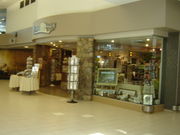
The airport contains a small historical display on both the main floor and observation area on the second floor. Retail outlets include a Relay outlet (including duty-free), and a Prairie Unique Gifts outlet. Food services consist of a Tim Hortons, the Crossroads Grill and The Prairie Elevator Restaurant & Lounge. Past pre-board screening there is a To Go outlet.
A SaskTel business centre is located across from the check-in counters. The Saskatoon Airport does not offer any business class lounges.
Ground transportation
Saskatoon Transit (Route No 11) provides city bus service between the airport and the downtown core and University of Saskatchewan campus.
Taxi service is provided from the airport, as well as several car rental agencies. Currently United Cabs Ltd. is the licensed provider of both taxi and limousine services.[16] Several hotels near the airport provide shuttle services.
Other Air Side Services
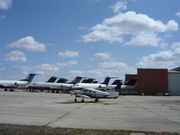
In addition to the main terminal the airport also contains a variety of additional buildings. These include the International Aviation Terminal (used by Air Canada Cargo, Anderson Aviation, Dryden Air-services and Karl's Air Services), a fire hall, Saskatoon Aerocentre (operated by West Wind Aviation), Purolator cargo facility and a variety of hangers used by various airlines.[17]
Many former Air Canada Jazz and Canadian Regional Airlines Fokker F28 aircraft have been stored at the airport since they were retired from the fleet in 2003.
Airlines and destinations
Scheduled service

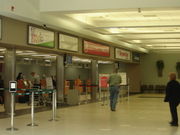
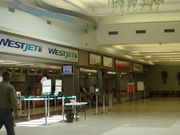
| Airlines | Destinations |
|---|---|
| Air Canada | Toronto-Pearson |
| Air Canada Jazz | Calgary, Edmonton, Ottawa, Vancouver, Winnipeg |
| Delta Connection operated by SkyWest Airlines | Minneapolis/St. Paul |
| Pronto Airways | Baker Lake [seasonal], Prince Albert, Points North, Rankin Inlet [seasonal], Stony Rapids, Uranium City, Wollaston |
| Transwest Air | Fond Du Lac, Fort McMurray, La Ronge, Points North, Prince Albert, Regina, Stony Rapids, Wollaston |
| United Express operated by SkyWest Airlines | Chicago-O'Hare, Denver |
| West Wind Aviation | Regina [departs Shell Aerocentre] |
| WestJet | Calgary, Cancun [seasonal], Edmonton, Las Vegas [seasonal], Montego Bay [seasonal; begins October 31], Puerto Vallarta [seasonal], Toronto-Pearson, Vancouver [seasonal] |
Charter service
| Airlines | Destinations |
|---|---|
| Air Transat | Cancun, Montego Bay, Puerto Plata, Puerto Vallarta, Punta Cana [all seasonal] |
| Sunwing Airlines | Cancun, Holguin, Varadero [all seasonal] |
Cargo service
| Airlines | Destinations |
|---|---|
| Cargojet Airways | Regina, Winnipeg [18] |
| Purolator Courier | |
| Purolator Courier operated by Kelowna Flightcraft Air Charter |
Accidents and incidents
- On May 22, 2008 a Canadian North Boeing 737-200 enroute from Fort MacKay/Horizon Airport encountered a major vibration and fire in the right engine on final approach to Saskatoon. The fire occurred when the aircraft was 50 m (160 ft) above the ground and 1,700 m (5,600 ft) from Runway 33. The aircraft had 102 passengers and 5 crew on board. There were no injuries. The aircraft was operating a charter service (Flight 1714) that was scheduled as Fort McKay/Horizon - Saskatoon - Montreal - Moncton.[19]
Gallery
 |
 |
 |
 |
 |
 |
 |
 |
 |
 |
 |
 |
See also
- Saskatoon/Corman Air Park
References
- ↑ 1.0 1.1 Canada Flight Supplement. Effective 0901Z 23 September 2010 to 0901Z 18 November 2010
- ↑ Airport Divestiture Status Report
- ↑ 3.0 3.1 Total aircraft movements by class of operation — NAV CANADA towers
- ↑ [1]
- ↑ 2005 Passenger Traffic at Saskatoon’s Airport sets new record
- ↑ John G. Diefenbaker Welcomes 1 Millionth Passenger of 2007 December 18, 2007 Press Release
- ↑ Facts & Figures
- ↑ 2004 Annual Report
- ↑ 75 years of Aviation History in Saskatoon
- ↑ Runway 09-27 April 15, 2008
- ↑ Rehabilitation of Runway 09-27, Taxiway Alpha (west) and foxtrot, and Apron VI and VII Construction Contract No. 0230-00-00-28 Plan of Construction Operations - Pryde Schropp McComb, Inc
- ↑ Saskatoon will get Denver flight
- ↑ Saskatoon, Chicago united
- ↑ [2]
- ↑ Isfeld, Gordon; Morris, Helen (July 5 2008), "Canadian airports flying high. Passenger numbers hitting record levels throughout country. Expansion: Saskatoon's airpot ' an asset to the community '", Saskatoon Star Phoenix Canwest News Services: D1 and D4, http://www.canada.com/saskatoonstarphoenix/
- ↑ Taxi services
- ↑ Airport Map
- ↑ http://www.cargojet.com/assets/FILES/CARGOJET_SCHD.pdf
- ↑ The Aviation Herald
External links
- Saskatoon/John G. Diefenbaker International Airport Homepage
- Past three hours METARs, SPECI and current TAFs for Saskatoon/John G. Diefenbaker International Airport from NAV CANADA as available.
Accident history for YXE at Aviation Safety Network
References
|
|||||||||||||||||